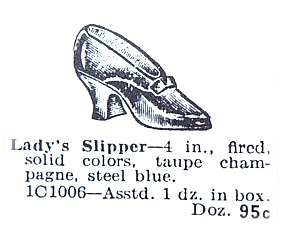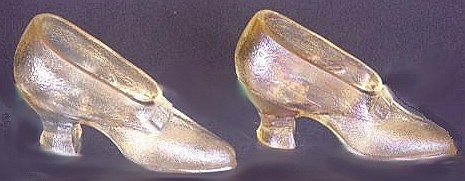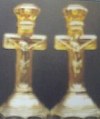Carnival Glass 101 | home Quick Reference to Carnival Glass Patterns on This Site
US Glass - Part 7
United States Glass Company - Part 7
(More Big News on U.S. Glass Carnival)
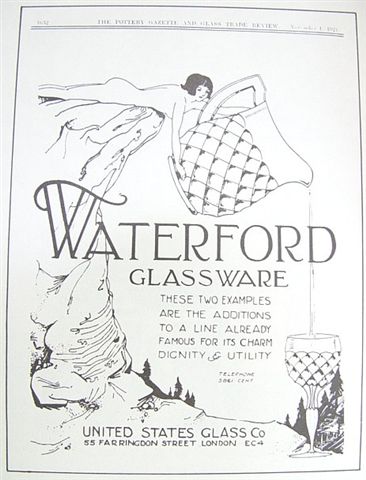
Clue to a link from U.S. Glass to English Waterford.
ANOTHER “Late” Carnival Pattern which has been copied by a number of factories during the 1920s and 1930s was popularly known as GEORGIAN. It was made by Fenton, Cambridge, Paden City, Duncan & Miller and in more recent years, Viking.
However, U.S. Glass is generally not mentioned as one of the manufacturers, but their WATERFORD pattern is a design along the same lines. Most GEORGIAN pieces have the six-sided honeycomb styling, but a few have four-sided diamonds at the center row (the Cambridge tumblers and the Fenton goblet, for example).
The USG version, which is ALL diamonds, is shown here again since the only listing we can find of this pattern is the poorly detailed drawings in Marion Hartung's Books 7 & 8, where she named the pattern “49'ER”. There is no way at this time to confirm the two patterns (and in fact that the “49'ER” tumbler and decanter set in the Hartung books) are the same, as no original catalogue has surfaced revealing the various shapes available in WATERFORD. We must also remember that this pattern name may have been used for the line ONLY in England, where U.S. pattern names were frequently changed to appeal to the British consumer.
Hartung describes the color of her “49'ER” tumbler as a deep marigold, so we can probably rule out the light golden-color found on cold-iridized “luster” pieces. The collared base of the tumbler she pictures is completely different from all those confusing GEORGIAN tumblers, so it is clear we are dealing here with a similar, but different, table line. The stopper shown in the MH 8-9 ½” liquor decanter seems to match the one found in the JACOBEAN cruet shown in a 1934 ad, a pattern known made in England after 1932. Marigold carnival was quite popular in England and the rest of Europe long after it had subsided here in the states. Many patterns were still being marketed in Europe in marigold color in the 1920s and later.
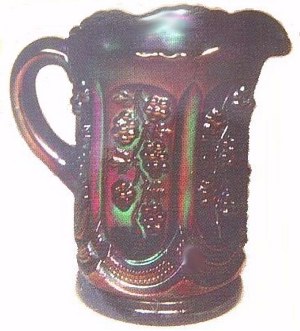 |
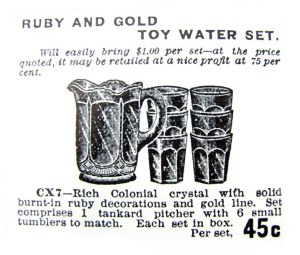 |
VIRGINIA BLACKBERRY Creamer
|
Toy Water Set
|
Another Possible U.S. Glass Rarity
During the lecture tour in northern California, Wm. Heacock was honored with an invitation to study Don Moore's collection of carnival glass. He was particularly interested in seeing the small BLACKBERRY 4 1/4” cream pitcher which is shown in Don's book, "The Shape of Things in Carnival Glass". Agreeing with Don that the deep color of cobalt blue and the iridescence is typically Fenton. However, the mold looks to be the same as the one used on the GALLOWAY toy water set (Lechler 2, p. 65,) with the addition of embossed berries inside the panels. We know that Fenton made an exact copy of the U.S. Glass' PENNSYLVANIA goblet mold, or perhaps bought a duplicate mold. Could Fenton also have copied the basic design of the GALLOWAY “tankard cream”, adding the berries on their own?
That is doubtful. First of all, this GALLOWAY and BLACKBERRY pitcher is the only one known, despite it being listed for ten years without positive identification - since 1975. If Fenton had made it during their peak carnival years, certainly some record of it should turn up in the company's well preserved archive material. Heacock believes this creamer dates after 1920, when U.S. Glass was making a cobalt blue color, and was iridizing their stretch glass line as well. Stating that he would have had some doubt had he not seen the FIELD THISTLE creamer in “pastel blue”, but maybe U.S. Glass was doing some testing of molds and colors during this period, and a few “super rarities” escaped the factory to become today's most sought after collectibles.
It would not be fair if we did not point out that the molds for GALLOWAY may have been acquired by other factories, much as many USG molds were used by Federal Glass Co.. A small GALLOWAY stemmed `sundae' appears in a circa 1920 -1925 catalogue of Jefferson Glass at Toronto , and the toothpick holder has been reproduced by St. Clair and Mosser in the early `80s, indicating some of the molds may have been sold by U.S. Glass.
This small child's pitcher is the only known iridized example. It was sold by Seeck Auctions in 1994 for $625.
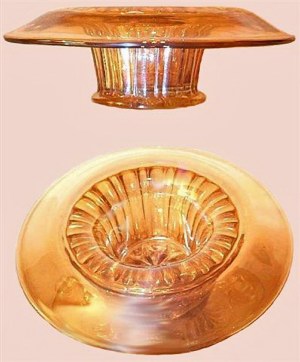 |
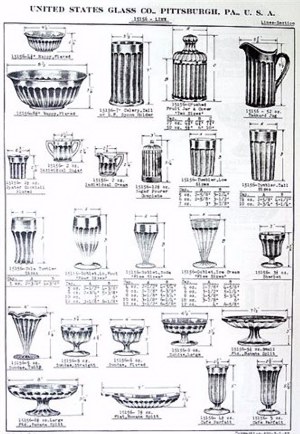 |
FRANKLIN FLUTE Hat Whimsey
|
Page from US Glass Catalog-1937
|
Said to have been made by U.S. Glass Factory G, this whimsey is of strong, rich marigold, with hints of light amber. Interior and exterior are highly iridized. 5 ½” in width outer edge to edge, 2” in height at its tallest point,
1 ½” in height at the lowest point, or the rim edge, 2” in width at the top inner opening with a base width of approx. 2 ¼” and a ¼” flare edge rim.
We believe it possible that the “whimsey” hat could have been formed from the Celery, shown in the catalog ad.
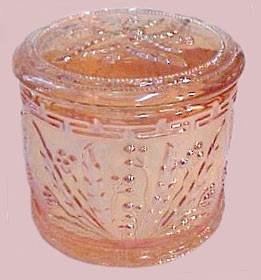
WILD BERRY Powder Jar
WILD BERRY Powder Jar - One of these sold for $300 in Jan. 2005 when Jim Wroda Auctions sold the Bernie & Nancy May collection.2.75 in. wide x 2.5 in. tall.
Few patterns in carnival glass offer this powder jar shape. An interesting aspect of this particular one is that no other shapes have been found to have this same design, they are always found in marigold, and there do not seem to be very many of them available to collectors. The Greek Key design along the top and lower rims create added interest in the pattern! 2.75 in. in diameter x 2.25 in. tall.
Thought to be of U.S. Glass origin, or possibly Westmoreland, we place this example where we feel it should be shown. It has the earmarks of an obscure piece from one of the 19 conglomerate manufacturers within that concern.
By all standards, a detailed design; one which would have been very attractive made into a complete dresser set.
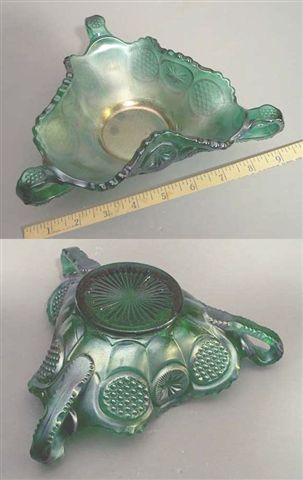
STATES Bonbon - First of its kind in Carnival Glass
Photos Courtesy Rick Kojis
Describing this three-handled green bonbon as the first known, one-of-a-kind, found in an Indiana home, Rick Kojis placed it on eBay in late Dec. 2005. $1046.56 was the selling price. Rick's comment that other iridized shapes in this pattern have been found in marigold, and that truly this bonbon qualifies as more rare than any of the Frolicking Bears tumblers, must be agreed with. 9 ½” each side-handle to handle, 3” high and with a 3 3/8” diameter collar base, weighing 1 1/2 lbs., we can certainly call this a large bonbon!
There are some differences in the pattern used on this bonbon, as compared to the design found on the butterdish and oval dish found in marigold States examples. This green bonbon lacks the outer circles/hobs, or dots found on the marigold shapes. We can say that there is a likeness among the designs, but whether the iridized examples in any of these shapes were actually produced by U.S. Glass or came from later Argentine production following sale of the molds, is an unknown factor.
U.S. Glass most assuredly produced green glass. Much of it was decorated with metallic gold. The possibility exists, that they could have produced a “half-turn or a full turn”- 200-400 pcs. of this obscure bonbon.
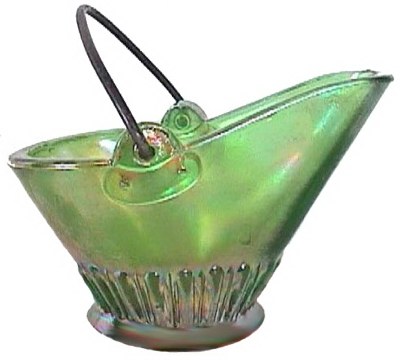
Coal Bucket
Here is a piece for miniature collectors, and one which is very rare in carnival glass. Novelty items are interesting, just as whimseys are curious. Many of us enjoy mixing a few small pieces with our collections of plates and bowls.
This particular item has been attributed to U.S. Glass Co. over the years; not that proof positive exists to support that theory.
These little buckets having a metal handle have been seen in clear and non-iridized examples, but the iridized examples have been found in green and marigold. The green one pictured here is like the one shown in the wholesale catalog ad which accompanies it, having a well-rounded edge. There are some examples known to provide a flattened area on the top edge of the pouring spout, as well as on the opposite end of the bucket, creating a cigarette rest. Patterning around the bases is similar, including the twenty rays impressed on the underside. Except for that, these pieces are quite different.
Perhaps one manufacturer tried to copy the product of another. Iridescence on the green bucket is flashed on, while that of the marigold bucket is fired on. Some of these pieces carry souvenir lettering-example: “Souvenir of Rochester, NY”.
A pretty marigold Coal Bucket - from the former Don Moore collection having souvenir printing form Hart Lake, PA was seen at the ICGA Convention auction in July 1998, when part of the collection of John & Lucile Britt was sold. It brought $95. The May 22, 2004 Seeck Auction sold a pretty green example for $275. Appears that this is another of those “reasonable rarities” we all like to pick up when we can.
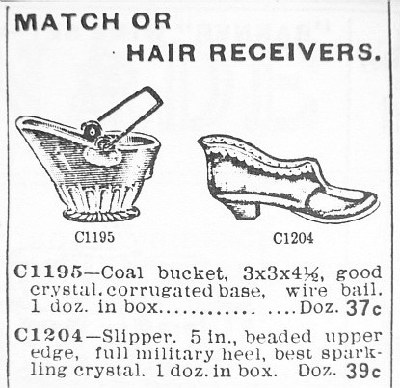
Coal Bucket and Ladies Slipper-Butler Bros.ad-Spring 1915.
1915 butler Bros. Ad: Indicates marketing of the Coal Bucket and the “high top” shoe in the same time frame.
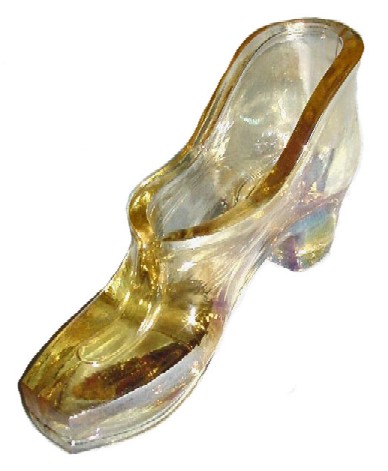
LADY'S SLIPPER - Courtesy Jerry & Carol Curtis
These lightly iridized miniatures bring substantial prices whenever they appear for sale. As we look at the Catalog ad for this shoe, it would seem that since they entered the spectrum of events about 1915 -1918, perhaps the souvenir aspect for tourism was being catered to with these small caricatures sold to fairs and exhibitions. They certainly have made a place for themselves among collectors! One of these sold for $135 at the 2004 Lincoln Land Carnival Glass Convention auction conducted by Ayers Auction Service.
The Curtis' own several varieties in glass slippers and we are delighted to display their “match” to the one shown in the 1915 Butler Brothers Catalog.
Desirability of such “items of frivolity” as these tiny glass shoes and the coal bucket, along with many other novelty examples were a sign of the care-free attitude developing in America, leading to the “spirit of the approaching 1920s”. Other such ads in the Butler Bros. Wholesale Catalogs indicate that small items such as these were purchased for Souvenirs, lettered with a date and event or place relating to travel, which was coming into its own at that time in history.
Dean & Diane Fry - 10/06
      |
|
“Aspire to lead a quiet life, to mind your own business, and to work with your own hands, as we commanded you” (1 Thessalonians 4:11); “If anyone will not work, neither shall he eat” (2 Thessalonians 3:10).
William Bradford transplanted the Protestant work ethic on a new continent, when as governor of the Plymouth Colony in the mid 1600s, he provided biblical and practical leadership. He divided the land among the colonists for privately owned farms, stressing personal responsibility and productivity by citing key Bible texts.
  Seeing God's work in our lives
Puts a new song on our lips.
|
|
      |
Should you care to contact the Frys, their email address is:
Search Our Sites
back to Carnival Glass 101
Our other sites you may enjoy:
Everything you EVER wanted to know about Indiana Glass
Great Reference for Newer Carnival Glass.
Complete Glassware Catalogs Available to Download
Questions? Comments? Suggestions? Broken Links? Corrections?
Your Friendly Webmaster is here to help!
